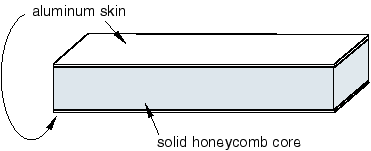Defining skin reinforcements | ||
| ||
The composite beam shown in Figure 1 is an example of how you might use a skin reinforcement in your model.

The beam has a solid honeycomb core and an aluminum skin on the upper and lower faces. You can create a solid part representing the honeycomb and add a skin reinforcement representing the aluminum layers. In the Mesh module you assign solid elements to the honeycomb and shell elements to the skin. The solid and shell elements share the same nodes.
Select from the main menu bar in the Property module to define one or more skins. Select Edit from the same menu to make changes to an existing definition. All skins you create also appear in the Model Tree in a Skins container under the part. Skins are not displayed in the viewport by default, but you can make them visible by color coding them in the viewport. See Coloring geometry and mesh elements, for more information.
If you create a skin on a geometry region, Abaqus/CAE updates the skin if you make minor modifications to the underlying geometry. If you edit orphan nodes or elements with a skin, Abaqus/CAE updates the skin if you edit or delete nodes or elements; however, it does not update the skin if you create new nodes or elements.
You may need to select the skin in subsequent modeling operations; for example, to:
-
Assign a homogeneous shell section, a composite shell section, a membrane section, a surface section, or a gasket section to a skin. Section assignments are performed in the Property module.
-
Assign a material orientation or rebar reference orientation to a skin. Both of these orientation assignments are performed in the Property module.
-
Assign a normal direction to a skin in the Property module. Although you cannot assign a normal direction to a skin directly, you can assign a normal direction to a face, which updates the normal direction of all skins defined on that face.
-
Prescribe a body force to the skin in the Load module.
-
Prescribe a thermal flux on the skin in the Load module. In practice, you perform this modeling operation by applying a thermal flux load to the underlying face or faces. Abaqus/CAE applies the load to all skins on that face during the analysis.
-
Assign an element type to the skin in the Mesh module.
-
Request field data output or history data output for the skin in the Step module.
-
Create a display group to view the stress values on the skin elements in the Visualization module. While you cannot specifically select skins by name in the Create Display Group dialog box, you can find them in this dialog box by searching for elements that share the same element type, section assignment, or another property as the skin elements in your model. This process can help you narrow down the list of elements to the skins you want to include.
When you are prompted to select a region for these modeling operations, select Skins from the list of object types in the Selection toolbar, and select the skin region from the viewport. For more information, see Filtering your selection based on the type of object.
When performing contact calculations, Abaqus/CAE considers a geometric surface's skin reinforcements only in certain cases; for example, when you specify general contact for all exterior surfaces, a default all-inclusive surface is defined automatically in Abaqus that will consider skin reinforcements. Skin reinforcements can significantly influence contact calculations, due to skin thickness and potential effects on numerical quantities such as contact penalty stiffness. To explicitly include skin reinforcements in a contact definition, you can create a set on the skin reinforcement and then use the set to define an element-based secondary surface in a contact pair definition in an Abaqus/Standard analysis or use the set to define a node-based secondary surface in a contact definition in an Abaqus/Explicit analysis.
For detailed information on creating a skin, see Creating and editing skin reinforcements.